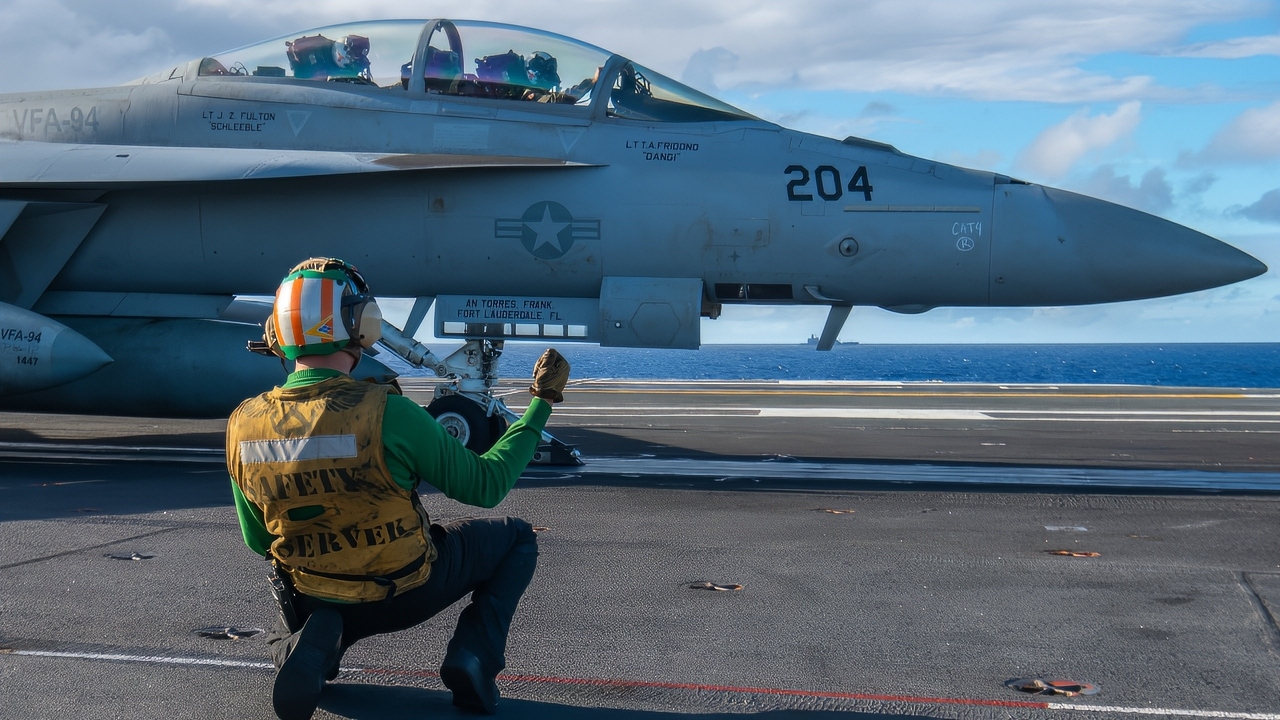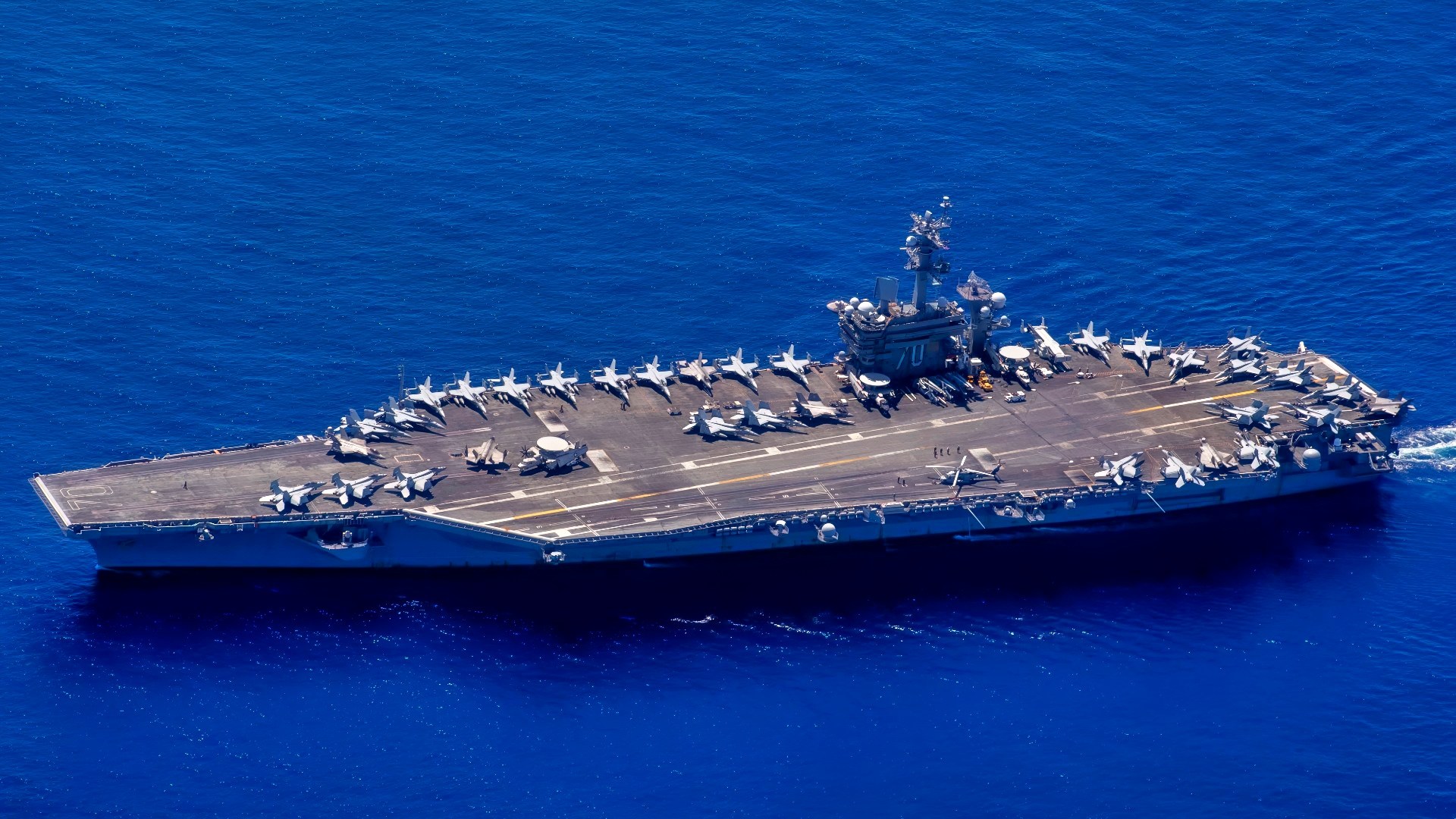Key Points and Summary – The U.S. Navy faces a potential crisis in carrier availability. Federal law mandates a minimum of 11 operational carriers, a number essential for maintaining global presence.
-However, the scheduled 2026 retirement of the USS Nimitz coincides with significant delays in the delivery of new Ford-class carriers like the USS John F. Kennedy.

SOUTH CHINA SEA (Jan. 17, 2025) – The Nimitz-class aircraft carrier USS Carl Vinson (CVN 70) transits the South China Sea during a Maritime Cooperative Activity with the Philippine Navy, Jan. 17, 2025. The U.S. and Philippines work together as allies, enhancing the interoperability of maritime forces and supporting their shared goal of a free and open Indo-Pacific. Carrier Strike Group ONE, is underway conducting routine operations in the U.S. 7th Fleet area of operations. (U.S. Navy photo by Mass Communication Specialist 3rd Class Brianna Walker)
-This convergence threatens to temporarily drop the fleet below the legal minimum, precisely when global demand is high and bottlenecks, labor shortages, and supply chain issues severely strain the U.S. shipbuilding industrial base.
-While increasing the fleet size is debated, the immediate challenge is ensuring uninterrupted capability amidst these pressures.
Is the U.S. Navy Running Out of Aircraft Carriers?
The U.S. Navy plans to retire the USS Nimitz (CVN-68) in May 2026, ending more than five decades of service. At the same time, construction delays are pushing the delivery of new Ford-class carriers several years behind schedule, and this raises a critical question.
Can the Navy maintain the number of carriers required by law, and does the United States actually have enough to meet today’s demands and pressures?
The Legal Requirement: Why We Must Have 11 Carriers
Federal law requires the U.S. Navy to maintain no fewer than 11 operational aircraft carriers at all times.
The mandate appears in Title 10, U.S. Code, Section 8062, and is a congressionally mandated minimum requirement enacted to ensure that the Navy can sustain global operations without leaving major regions unattended.
Carriers operate on a long readiness cycle whereby roughly one-third of the fleet is deployed, one-third is preparing for deployment or in transit, and the final third is undergoing maintenance or overhaul. Maintaining 11 shops allows the Navy to keep about four to six carriers fully deployable at any given time.

U.S. Navy Aviation Boatswain’s Mate Aircraft Handling 2nd Class Kyle Darmanin, from Mooresville, North Carolina, assigned to air department’s flight deck crash and salvage division, signals an F/A-18E Super Hornet, attached to Strike Fighter Squadron (VFA) 27, on the flight deck of Nimitz-class aircraft carrier USS George Washington (CVN 73) while underway in the Timor Sea in support of Talisman Sabre 2025, July 14, 2025. Talisman Sabre is the largest bilateral military exercise between Australia and the United States advancing a free and open Indo-Pacific by strengthening relationships and interoperability among key allies and partners, while enhancing our collective capabilities to respond to a wide array of potential security concerns. (U.S. Navy photo by Mass Communication Specialist 2nd Class Tyler Crowley)
That ensures a continuous presence in the Indo-Pacific, Middle East, and Atlantic simultaneously – but only just.
The law does, in fact, allow some temporary waivers. For example, when USS Enterprise retired in 2012 before USS Gerald R. Ford (CVN-78) entered service, but these gaps are meant to be brief.
Today, however, gaps like this could present serious challenges, as near-peer adversaries like China are rapidly expanding their own naval capabilities.
So, do we have enough?
The Current Fleet and Its Limits
Today, the Navy operates 10 Nimitz-class carriers and one Ford-class.
The Ford achieved initial deployment in 2023 after years of testing, but the second ship, USS John F. Kennedy (CVN-79), has experienced repeated schedule slips and delays.
According to the Congressional Research Service, Kennedy will not be delivered until at least 2027, with follow-on vessels USS Enterprise (CVN-80) and USS Doris Miller (CVN-81) extending into the 2030s.
Each new ship introduces new technologies that require significant debugging, including the Electromagnetic Aircraft Launch System (EMALS) and Advanced Arresting Gear (AAG), as well as the Advanced Weapons Elevators.

(Dec. 31, 2022) An F/A-18E Super Hornet assigned to the “Mighty Shrikes” of Strike Fighter Squadron (VFA) 94 prepares to launch from the aircraft carrier USS Nimitz (CVN 68) to participate in a long-range maritime strike demonstration. Nimitz is in 7th Fleet conducting routine operations. 7th Fleet is the U.S. Navy’s largest forward-deployed numbered fleet, and routinely interacts and operates with 35 maritime nations in preserving a free and open Indo-Pacific region. (U.S. Navy photo by Mass Communication Specialist 2nd Class Justin McTaggart)
These systems promise faster flight operations and reduced maintenance, but have so far caused delays. As a result, the Navy technically remains at its statutory minimum of 11 carriers, but only a portion of those carriers are available for deployment at any one time.
In practice, the United States often has five or fewer carriers ready for combat operations worldwide – and a gap could be on our doorstep.
If Nimitz is retired before Kennedy becomes fully operational, the fleet could dip to 10 active carriers – below the legal requirement.
And while that gap may be short-lived, it will still arrive at a time of unusually high operational demand.
Carrier strike groups are currently active in the Mediterranean, Red Sea, and Western Pacific, supporting deterrence missions against Iran, China, and Russia. Each deployment lasts several months and often extends beyond its planned schedule to cover simultaneous crises.
The result is more extended tours for sailors—and worse, it means smaller windows for maintenance.
Industrial Base Constraints
The U.S. Navy would benefit from additional carriers, but funding and congressional support are only two pieces of a much bigger puzzle. To achieve this, the U.S. industrial base would need to be capable of handling such a task.
At present, the Newsport News facility in Virginia is the only U.S. shipyard capable of constructing or refueling nuclear-powered carriers. It also handles work on Virginia- and Columbia-class submarines. Between labor shortages, limited dock space, and supply chain problems, managing the existing fleet is already challenging work.
A 2024 Pentagon review found widespread delays across the Navy’s shipbuilding programs owing to a lack of skilled workers and parts availability, while another study found that almost 70 percent of sole-source suppliers supporting carrier production already risk leaving the market entirely without sustained procurement funding.
What Does the Future Look Like?
Many have argued that the statutory minimum of 11 carriers should be increased.
A fleet of 12 or 13 carriers would better align with the Navy’s operational needs and the demands of global deterrence. With China’s People’s Liberation Army Navy launching its third carrier (Fujian) and planning more, the United States risks losing numerical and regional presence advantages over time.
Expanding the carrier fleet would also provide greater flexibility during extended maintenance periods or after wartime damage; however, doing so would require significant investment in escort ships, aircraft, personnel, and improvements to America’s industrial capacity.
It would mean a massive expansion of the industrial base, which is currently hard to envision.
That being said, warfare is changing, and while carriers have been criticized as a relic and too vulnerable to emerging technologies, the arrival of unmanned aerial vehicles (UAVs) will change how they are used.
The Navy is beginning to integrate UAVs into carrier air wings, with the MQ-25 Stingray refueling drone having already completed initial deck trials. Future programs also envision unmanned strike and reconnaissance aircraft – systems that could extend operational range, reduce pilot risk, help protect aircraft carriers from threats, and allow each carrier to project power more efficiently.
For these new technologies to be beneficial, however, the U.S. urgently needs to address its lagging industrial capacity – and consider increasing its statutory minimum.
About the Author:
Jack Buckby is a British author, counter-extremism researcher, and journalist based in New York. Reporting on the U.K., Europe, and the U.S., he works to analyze and understand left-wing and right-wing radicalization, and reports on Western governments’ approaches to the pressing issues of today. His books and research papers explore these themes and propose pragmatic solutions to our increasingly polarized society. His latest book is The Truth Teller: RFK Jr. and the Case for a Post-Partisan Presidency.
More Military
China’s New Aircraft Carrier Has 1 Big Advantage over the U.S. Navy
The B-21 Raider Stealth Bomber Has a New Problem: The Government Shutdown
The B-1B Lancer Bomber Has a Message for the Air Force
The B-2 Spirit Bomber Has 1 Big Advantage over Russia and China
Nuclear Aircraft Carrier USS Nimitz Will Be Retired Next Year: It Might Be a Big Mistake










